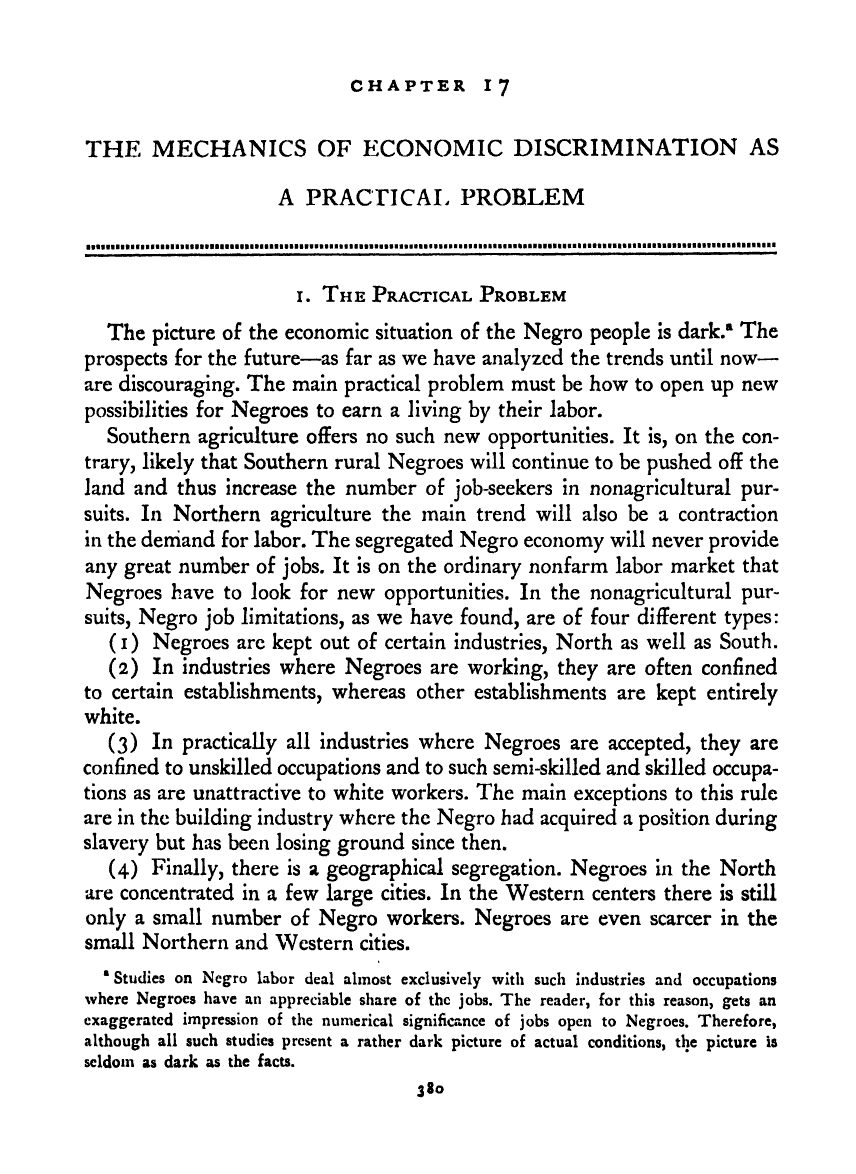Note: Gunnar Myrdal died in 1987, less than 70 years ago. Therefore, this work is protected by copyright, restricting your legal rights to reproduce it. However, you are welcome to view it on screen, as you do now. Read more about copyright.
Full resolution (TIFF) - On this page / på denna sida - IV. Economics - 17. The Mechanics of Economic Discrimination as a Practical Problem - 1. The Practical Problem

<< prev. page << föreg. sida << >> nästa sida >> next page >>
Below is the raw OCR text
from the above scanned image.
Do you see an error? Proofread the page now!
Här nedan syns maskintolkade texten från faksimilbilden ovan.
Ser du något fel? Korrekturläs sidan nu!
This page has never been proofread. / Denna sida har aldrig korrekturlästs.
CHAPTER 17
THE MECHANICS OF ECONOMIC DISCRIMINATION AS
A PRACTICAL PROBLEM
I. The Practical Problem
The picture of the economic situation of the Negro people is dark.® The
prospects for the future—as far as we have analyzed the trends until now
—
are discouraging. The main practical problem must be how to open up new
possibilities for Negroes to earn a living by their labor.
Southern agriculture offers no such new opportunities. It is, on the con-
trary, likely that Southern rural Negroes will continue to be pushed off the
land and thus increase the number of job-seekers in nonagricultural pur-
suits. In Northern agriculture the main trend will also be a contraction
in the derriand for labor. The segregated Negro economy will never provide
any great number of jobs. It is on the ordinary nonfarm labor market that
Negroes have to look for new opportunities. In the nonagricultural pur-
suits, Negro job limitations, as we have found, are of four different types:
(1) Negroes arc kept out of certain industries, North as well as South.
(2) In industries where Negroes are working, they are often confined
to certain establishments, whereas other establishments are kept entirely
white.
(3) In practically all industries where Negroes are accepted, they are
confined to unskilled occupations and to such semi-skilled and skilled occupa-
tions as are unattractive to white workers. The main exceptions to this rule
are in the building industry where the Negro had acquired a position during
slavery but has been losing ground since then.
(4) Finally, there is a geographical segregation. Negroes in the North
are concentrated in a few large cities. In the Western centers there is still
only a small number of Negro workers. Negroes are even scarcer in the
small Northern and Western cities.
* Studies on Negro labor deal almost exclusively with such industries and occupations
where Negroes have an appreciable share of the jobs. The reader, for this reason, gets an
exaggerated impression of the numerical significance of jobs open to Negroes. Therefore,
although all such studies present a rather dark picture of actual conditions, the picture is
seldom as dark as the facts.
380
<< prev. page << föreg. sida << >> nästa sida >> next page >>